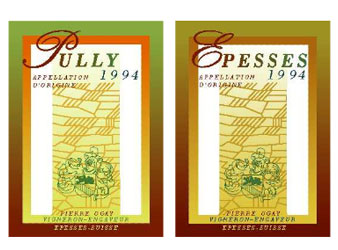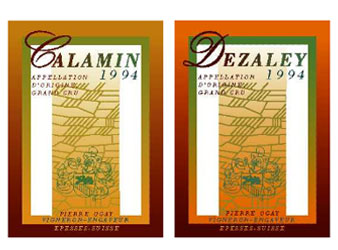   
Six Wine Labels:
Four whites, two reds, the production of a wine maker unified into one series
The family Ogay has been wine maker from father to son since 3 generations. Offering a relatively small production if you compare it with the American standards, the wine makers of the region of Lavaux situated on the southern side of Switzerland, on the hills of the lake of Geneva are well known in the entire country. Their region has been chosen to be one of the Unesco's World Heritage territory and therefore became internationally reknowned.
Because of the steepness of the hills, the method of growing grapes around this small village situated over the lake has been kept traditional and almost similar since the 12th century. As the working conditions are very hard and no tractor can pass between the vineyards, the plants requires from the cut of the twining stems in Winter to the harvest in the Fall the action of the men. This close contact of winemakers with nature and their grapes give to the wine of Lavaux an exceptional taste, recognized throughout the entire Switzerland. According the changes of their vineyards, the family Ogay had developed over the years different labels, which design had passed from one generation to the other and it was time to unify them for a better marketing. As a visual approach we choose to use the rhythm of the walls separating the vineyards Thise famous terraces are in continuous use and have been well maintained since the 12th century. The second important element was to integrate the armories of the family and to change the color scheme of each label according their position in the vineyard, one wine being more fruity than the other according its position in the region. The wine is a traditional product, and it was important to us that this winemaker and it's family were in complete collaboration with the development of the visual of their labels, and as we also developed their new logo, we had the honor with this series, to reinforce their presence from the second to the third millennium. |


